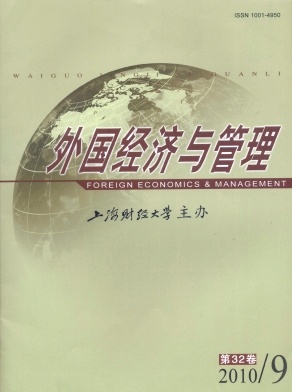全球整合—当地响应范式应用研究回顾与展望
外国经济与管理 2010 年 第 32 卷第 09 期, 页码:16 - 22
摘要
参考文献
摘要
平衡全球整合(global integration,GI)和当地响应(local responsiveness,LR)之间的关系是企业要想取得跨国经营管理成功的重要前提。长期以来,全球整合—当地响应(下称GI-LR)范式在跨国经营管理研究中一直占据着重要的地位,但是,该范式的应用价值在跨国管理实践和新的管理现象研究中并未得到充分的体现。本文从研究主题、成果及设计三个方面对该范式的应用研究进行了回顾和评价,重点分析了现有研究存在的不足及其原因,并对该范式的未来应用研究进行了简要展望。
关键词
[1]Brock,D M,and Birkinshaw,J.Multinational strategy and structure:Areview and research agenda[J].Management Interna-tional Review,2004,44(1):5-14.
[2]Doz,Y,and Prahalad,C K.Patterns of strategic control within multinational corporations[J].Journal of International BusinessStudies,1984,15(2):55-72.
[3]Bartlett,C A.Building and managing the transnational:The neworganizational challenge[A].in Porter,ME(Ed.).Competitionin global industries[C].Boston,MA:Harvard Business School Press,1986.
[4]Roth,K,and Morrison,AJ.An empirical analysis of the integration-responsiveness frameworkin global industries[J].Journalof International Business Studies,1990,21(4):541-565.
[5]Julius,J HJ.An empirical analysis of the integration-responsiveness framework:US construction equipment industry firms inglobal competition[J].Journal of International Business Studies,1995,26(3):621-636.
[6]Taggart,J H,and Harding,MS.The process of subsidiary strategy:Astudy of Ciba-Geigy classical pigments[J].ManagementDecision,1998,36(9):568-579.
[7]Bartlett,C A,and Ghoshal,S.Managing across borders:The transnational solution[M].Boston,MA:Harvard Business SchoolPress,1989:57-72.
[8]Jarillo,J C,and Martinez,J I.Different roles for subsidiaries:The case of multinational corporations in Spain[J].Strategic Mana-gement Journal,1990,11(3):501-512.
[9]Taggart,J H.An evaluation of the integration-responsiveness framework:MNC manufacturing subsidiaries in the UK[J].Mana-gement International Review,1997,37(4):295-318.
[10]Wasilewski,N.An empirical study of the desirability and challenges of i mplementing transnational marketing strategies[J].Ad-vances in Competitiveness Research,2002,10(1):123-160.
[11]Sullivan,D,and Bauerschmidt,A.The“basic concepts”of international business strategy:Areview and reconsideration[J].Management International Review,1991,31(1):111-124.
[12]毛蕴诗,汪建成.在华跨国公司战略选择与经营策略问题研究[J].管理科学学报,2009,12(2):117-124.
[13]Grein,A F,Craig,C S,and Takada,H.Integration and responsiveness:Marketing strategies of Japanese and European auto-mobile manufacturers[J].Journal of International Marketing,2001,9(2):19-51.
[14]Paik,Y,and Sohn,J H D.Striking a balance between global integration and local responsiveness[J].Organizational Analysis,2004,12(4):347-360.
[15]Enright,MJ.Regional management centers in the Asia-Pacific[J].Management International Review,2005,45(1):59-82.
[16]Tsai,M T,Yu,MC,and Lee,K W.Relationships between subsidiary strategic roles and organizational and configuration:Thecase of Tai wanese multinational companies[J].International Journal of Commerce&Management,2006,16(1):3-15.
[17]Hannon,J M,Huang,I-C,and Jaw,B-S W.International human resource strategy and its determinants:The case of subsidia-ries in Tai wan[J].Journal of International Business Studies,1995,26(3):531-555.
[18]Rijamampianin,A W MB R.Buildingflexibilityinto multinational human resource strategy:Astudy of four South African mul-tinational enterprises[J].Int.J.of Human Resource Management,2007,18(5):829-844.
[19]Sauers,D A,Lin,S C H,Kennedy,J,and Schrenkler,J.Acomparison of the performance appraisal practices of US multina-tional subsidiaries with parent company and local Tai wanese practices[J].Management Research News,2009,32(3):286-296.
[20]Fan,D,and Nyland,C et al.Strategic i mplications of global integration and local responsiveness for Chinese multinationals:Anarea for future study[J].Management Research News,2008,31(12):922-940.
[2]Doz,Y,and Prahalad,C K.Patterns of strategic control within multinational corporations[J].Journal of International BusinessStudies,1984,15(2):55-72.
[3]Bartlett,C A.Building and managing the transnational:The neworganizational challenge[A].in Porter,ME(Ed.).Competitionin global industries[C].Boston,MA:Harvard Business School Press,1986.
[4]Roth,K,and Morrison,AJ.An empirical analysis of the integration-responsiveness frameworkin global industries[J].Journalof International Business Studies,1990,21(4):541-565.
[5]Julius,J HJ.An empirical analysis of the integration-responsiveness framework:US construction equipment industry firms inglobal competition[J].Journal of International Business Studies,1995,26(3):621-636.
[6]Taggart,J H,and Harding,MS.The process of subsidiary strategy:Astudy of Ciba-Geigy classical pigments[J].ManagementDecision,1998,36(9):568-579.
[7]Bartlett,C A,and Ghoshal,S.Managing across borders:The transnational solution[M].Boston,MA:Harvard Business SchoolPress,1989:57-72.
[8]Jarillo,J C,and Martinez,J I.Different roles for subsidiaries:The case of multinational corporations in Spain[J].Strategic Mana-gement Journal,1990,11(3):501-512.
[9]Taggart,J H.An evaluation of the integration-responsiveness framework:MNC manufacturing subsidiaries in the UK[J].Mana-gement International Review,1997,37(4):295-318.
[10]Wasilewski,N.An empirical study of the desirability and challenges of i mplementing transnational marketing strategies[J].Ad-vances in Competitiveness Research,2002,10(1):123-160.
[11]Sullivan,D,and Bauerschmidt,A.The“basic concepts”of international business strategy:Areview and reconsideration[J].Management International Review,1991,31(1):111-124.
[12]毛蕴诗,汪建成.在华跨国公司战略选择与经营策略问题研究[J].管理科学学报,2009,12(2):117-124.
[13]Grein,A F,Craig,C S,and Takada,H.Integration and responsiveness:Marketing strategies of Japanese and European auto-mobile manufacturers[J].Journal of International Marketing,2001,9(2):19-51.
[14]Paik,Y,and Sohn,J H D.Striking a balance between global integration and local responsiveness[J].Organizational Analysis,2004,12(4):347-360.
[15]Enright,MJ.Regional management centers in the Asia-Pacific[J].Management International Review,2005,45(1):59-82.
[16]Tsai,M T,Yu,MC,and Lee,K W.Relationships between subsidiary strategic roles and organizational and configuration:Thecase of Tai wanese multinational companies[J].International Journal of Commerce&Management,2006,16(1):3-15.
[17]Hannon,J M,Huang,I-C,and Jaw,B-S W.International human resource strategy and its determinants:The case of subsidia-ries in Tai wan[J].Journal of International Business Studies,1995,26(3):531-555.
[18]Rijamampianin,A W MB R.Buildingflexibilityinto multinational human resource strategy:Astudy of four South African mul-tinational enterprises[J].Int.J.of Human Resource Management,2007,18(5):829-844.
[19]Sauers,D A,Lin,S C H,Kennedy,J,and Schrenkler,J.Acomparison of the performance appraisal practices of US multina-tional subsidiaries with parent company and local Tai wanese practices[J].Management Research News,2009,32(3):286-296.
[20]Fan,D,and Nyland,C et al.Strategic i mplications of global integration and local responsiveness for Chinese multinationals:Anarea for future study[J].Management Research News,2008,31(12):922-940.
引用本文
刘燕, 赵曙明. 全球整合—当地响应范式应用研究回顾与展望[J]. 外国经济与管理, 2010, 32(9): 16–22.
导出参考文献,格式为:
上一篇:国外团队跨界行为研究回顾与展望





 10725
10725  581
581

